Land Degradation by Soil Erosion in Nepal: A Review
Abstract
:1. Introduction
2. Land Degradation in Nepal
3. Accelerated Soil Erosion and Its Causes
3.1. Impacts of Land-Use on Erosion
3.2. Impacts of Environmental Factors on Erosion
3.3. Impacts of Management Factors on Erosion
4. Erosion Effects on Nutrient Loss and Crop Productivity
5. Restoration Measures
- Maintaining vegetative cover to minimise direct impacts of raindrops and to impede surface flow [46];
- Improving soil physical conditions to prevent crusting, increase infiltration and reduce surface runoff, and adopting conservation agricultural practices [54];
- Removing excess water overflow through suitable engineering techniques [55]; and
- Following agricultural practices such as terracing so as to reduce slope length [56] to minimise the build-up of surface runoff.
5.1. Manuring and Fertilisation
5.2. Mulching
5.3. Cover Crop Management
5.4. Strip Planting
5.5. Contour Farming
5.6. Conservation Tillage
5.7. Bioengineering Techniques
6. National Initiatives to Cope with Soil Erosion and Land Degradation
7. Conclusions
Supplementary Materials
Author Contributions
Funding
Acknowledgments
Conflicts of Interest
References
- Lal, R. Soil degradation by erosion. Land Degrad. Dev. 2001, 12, 519–539. [Google Scholar] [CrossRef]
- Turner, K.G.; Anderson, S.; Gonzales-Chang, M.; Costanza, R.; Courville, S.; Dalgaard, T.; Dominati, E.; Kubiszewski, I.; Ogilvy, S.; Porfirio, L. A review of methods, data, and models to assess changes in the value of ecosystem services from land degradation and restoration. Ecol. Modell. 2016, 319, 190–207. [Google Scholar] [CrossRef]
- Acharya, A.K.; Kafle, N. Land degradation issues in Nepal and its management through agroforestry. J. Agric. Environ. 2009, 10, 133–143. [Google Scholar] [CrossRef]
- Pimentel, D. Soil erosion: A food and environmental threat. Environ. Dev. Sustain. 2006, 8, 119–137. [Google Scholar] [CrossRef]
- Guerra, A.J.T.; Fullen, M.A.; Jorge, M.d.C.O.; Bezerra, J.F.R.; Shokr, M.S. Slope processes, mass movement and soil erosion: A review. Pedosphere 2017, 27, 27–41. [Google Scholar] [CrossRef]
- Karkee, K. Land degradation in Nepal: A Menace to Economy and Ecosystems. Master’s Thesis, Lund University, Lund, Sweden, 2004. [Google Scholar]
- Ghimire, C.P.; Bonell, M.; Bruijnzeel, L.A.; Coles, N.A.; Lubczynski, M.W. Reforesting severely degraded grassland in the Lesser Himalaya of Nepal: Effects on soil hydraulic conductivity and overland flow production. J. Geophys. Res. Earth Surf. 2013, 118, 2528–2545. [Google Scholar] [CrossRef]
- Gardner, R.; Gerrard, A. Runoff and soil erosion on cultivated rainfed terraces in the Middle Hills of Nepal. Appl. Geogr. 2003, 23, 23–45. [Google Scholar] [CrossRef]
- Gautam, D.R. Environmental Risk in Nepal: A General Assessment. Tribhuvan Univ. J. 1993, 16, 87–93. [Google Scholar]
- Uddin, K.; Murthy, M.; Wahid, S.M.; Matin, M.A. Estimation of soil erosion dynamics in the Koshi basin using GIS and remote sensing to assess priority areas for conservation. PLoS ONE 2016, 11, e0150494. [Google Scholar] [CrossRef] [PubMed]
- Chalise, D.; Kumar, L.; Shriwastav, C.P.; Lamichhane, S. Spatial assessment of soil erosion in a hilly watershed of Western Nepal. Environ. Earth Sci. 2018, 77, 685. [Google Scholar] [CrossRef]
- Carson, B. Erosion and Sedimentation Processes in the Nepalese Himalya; ICIMOD Occasional Paper No. 1; ICIMOD: Kathmandu, Nepal, 1985. [Google Scholar]
- Byers, A.C. Landscape change and man-accelerated soil loss: The case of the Sagarmatha National Park. Mt. Res. Dev. 1987, 7, 209–216. [Google Scholar] [CrossRef]
- Sherchan, D.; Chand, S. A review of current soils related research activities at Pakhribas Regional Agricultural Centre. In Proceedings of the Soil Fertility and Erosion Issues in the Middle Mountains of Nepal, Ottawa, Canada, 22–25 April 1991; pp. 83–104. [Google Scholar]
- Maskey, R.; Joshi, D. Soil and nutrient losses under different soil management in the middle mountains of Nepal. In Proceedings of the Soil Fertility and Erosion Issues in the Middle Mountains Nepal, Ottawa, Canada, 22–25 April 1991; pp. 105–120. [Google Scholar]
- Ries, J. Soil Erosion in the High Mountain Regions, Eastern Central Himalaya. A Case Study in Bamti/Bhandara/Surma Area. Ph.D. Thesis, Albert-LudwigsUniversitàt, Freiburg, Germany, 1993. [Google Scholar]
- Watanabe, T. Soil erosion on Yak-grazing steps in the Langtang Himal, Nepal. Mt. Res. Dev. 1994, 14, 171–179. [Google Scholar] [CrossRef]
- Carver, M.; Nakarmi, G. The effect of surface conditions on soil erosion and stream suspended sediments. In Proceedings of the Challenges in Mountain Resource Management in Nepal: Processes, Trends and Dynamics in Middle Mountain Watersheds, Ottawa, Canada, 10–12 April 1995; pp. 155–162. [Google Scholar]
- Watershed Management Project. Department of Soil Conservation. Kulekhani Soil Loss and Runoff Plot. Annual Report 1994/95; Watershed Management Project: Kathmandu, Nepal, 1995. [Google Scholar]
- Watershed Management Project. Department of Soil Conservation. Soil Loss and Runoff Study at Subbakuna Demonstration Centre, Surkhet. Annual Report 1994/95; Watershed Management Project: Kathmandu, Nepal, 1995. [Google Scholar]
- Shrestha, A.B.; Aryal, R. Climate change in Nepal and its impact on Himalayan glaciers. Reg. Environ. Chang. 2011, 11, 65–77. [Google Scholar] [CrossRef]
- Joshi, A.R.; Shrestha, S.L.; Joshi, K. Environmental management and sustainable development at the crossroad. Mt. Res. Dev. 2003, 26, 383–384. [Google Scholar]
- Ministry of Environment Science and Technology. Third National Report on the Implementation of UN Convention to Combat Desertification; Ministry of Environment Science and Technology: Kathmandu, Nepal, 2006.
- Carson, B. The land, the Farmer and the Future: A soil fertility Management Strategies for Nepal. Presented at International Centre for Integrated Mountain Development (ICIMOD), Kathmandu, Nepal, 1992. [Google Scholar]
- Joshy, D.; Pandey, S.; Munankarmy, R. The Role of Integrated Plant Nutrition Systems in Sustainable and Environmentally Sound Agricultural Development; RAPA Publication (FAO): Kathmandu, Nepal, 1993. [Google Scholar]
- Government of Nepal, Ministry of Environment, Science and Technology. Nepal Thematic Assessment Report: Land Degradation; Government of Nepal, Ministry of Environment, Science and Technology: Kathmandu, Nepal, 2008.
- Zuazo, V.H.D.; Pleguezuelo, C.R.R. Soil-erosion and runoff prevention by plant covers. A review. In Sustainable Agriculture; Lichtfouse, E., Navarrete, M., Debaeke, P., Veronique, S., Alberola, C., Eds.; Springer: Dordrecht, The Netherlands, 2009; pp. 785–811. [Google Scholar]
- Acharya, G.P.; McDonald, M.A.; Tripathi, B.P.; Gardner, R.M.; Mawdesley, K.J. Nutrient losses from rain-fed bench terraced cultivation systems in high rainfall areas of the mid-hills of Nepal. Land Degrad. Dev. 2007, 18, 486–499. [Google Scholar] [CrossRef]
- Bajracharya, R.M.; Sherchan, D.P. Fertility status and dynamics of soils in the Nepal Himalaya: A review and analysis. In Soil Fertility; Nova Science Publishers, Inc.: New York, NY, USA, 2009; pp. 111–135. [Google Scholar]
- Bayramin, İ.; Basaran, M.; Erpul, G.; Canga, M.R. Assessing the effects of land use changes on soil sensitivity to erosion in a highland ecosystem of semi-arid Turkey. Environ. Monit. Assess. 2008, 140, 249–265. [Google Scholar] [CrossRef] [PubMed]
- Ochoa-Cueva, P.; Fries, A.; Montesinos, P.; Rodríguez-Díaz, J.A.; Boll, J. Spatial estimation of soil erosion risk by land-cover change in the Andes of southern Ecuador. Land Degrad. Dev. 2015, 26, 565–573. [Google Scholar] [CrossRef]
- Simonneaux, V.; Cheggour, A.; Deschamps, C.; Mouillot, F.; Cerdan, O.; Le Bissonnais, Y. Land use and climate change effects on soil erosion in a semi-arid mountainous watershed (High Atlas, Morocco). J. Arid. Environ. 2015, 122, 64–75. [Google Scholar] [CrossRef]
- Zare, M.; Mohammady, M.; Pradhan, B. Modeling the effect of land use and climate change scenarios on future soil loss rate in Kasilian watershed of northern Iran. Environ. Earth Sci. 2017, 76, 305. [Google Scholar] [CrossRef]
- Anache, J.A.; Flanagan, D.C.; Srivastava, A.; Wendland, E.C. Land use and climate change impacts on runoff and soil erosion at the hillslope scale in the Brazilian Cerrado. Sci. Total Environ. 2018, 622, 140–151. [Google Scholar] [CrossRef] [PubMed]
- Li, L.; Wang, Y.; Liu, C. Effects of land use changes on soil erosion in a fast developing area. Int. J. Environ. Sci. Technol. 2014, 11, 1549–1562. [Google Scholar] [CrossRef]
- Chalise, D.; Kumar, L. Land Use Change Impacts on Soil Erosion Dynamics in Western Nepal; University of New England: Armidale, Australia, 2018. [Google Scholar]
- Morgan, R.P.C. Soil Erosion and Conservation, 3rd ed.; Blackwell Publishing: Massachusetts, MA, USA, 2009. [Google Scholar]
- Harper, D. Improving the accuracy of the universal soil loss equation in Thailand. In Proceedings of the Fifth International Conservation Conferences, Bangkok, Thailand; 1987. [Google Scholar]
- Chalise, S.; Khanal, N. Erosion processes and their implications in sustainable management of watersheds in Nepal Himalayas. In Proceedings of the Regional Hydrology: Concepts and Models for Sustainable Water Resource Management, Postojna, Slovenia, 30 September–4 October 1997; pp. 325–334. [Google Scholar]
- Thapa, G.; Paudel, G. Farmland degradation in the mountains of Nepal: A study of watersheds ‘with’and ‘without’external intervention. Land Degrad. Dev. 2002, 13, 479–493. [Google Scholar] [CrossRef]
- Holz, D.J.; Williard, K.W.; Edwards, P.J.; Schoonover, J.E. Soil erosion in humid regions: A review. J. Contemp. Water Res. Educ. 2015, 154, 48–59. [Google Scholar] [CrossRef]
- Upreti, B. The physiography and geology of Nepal and their bearing on the landslide problem. In Landslide Hazard Mitigation in the Hindu Kush-Himalayas; International Centre for Integrated Mountain Development: Kathmandu, Nepal, 2001; pp. 31–49. [Google Scholar]
- Atreya, K.; Sharma, S.; Bajracharya, R.M.; Rajbhandari, N.P. Developing a sustainable agro-system for central Nepal using reduced tillage and straw mulching. J. Environ. Manag. 2008, 88, 547–555. [Google Scholar] [CrossRef] [PubMed]
- Atreya, K.; Sharma, S.; Bajracharya, R.M.; Rajbhandari, N.P. Applications of reduced tillage in hills of central Nepal. Soil Tillage Res. 2006, 88, 16–29. [Google Scholar] [CrossRef]
- Bajaracharya, R.M. Land preparation: An integral part of farming systems in the mid-hills of Nepal. Nepal J. Sci. Technol. 2015, 3. [Google Scholar]
- Mohammad, A.G.; Adam, M.A. The impact of vegetative cover type on runoff and soil erosion under different land uses. Catena 2010, 81, 97–103. [Google Scholar] [CrossRef]
- Atreya, K. Management Effects on Soil and Nutrient Losses and Crop Productivity in Maize-Based Cropping Systems of the Central Nepal Mid-Hills. Master’s Thesis, Kathmandu University, Kathmandu, Nepal, 2002. [Google Scholar]
- Schreier, H.; Shah, P. Soil fertility status and dynamics in the Jhikhu and Yarsha Khola watersheds. In Proceedings of the People and Resource Dynamics Project: The First Three Years (1996–1999), Baoshan, China, 2–5 March 1999; pp. 281–289. [Google Scholar]
- Lal, R.; Ahmadi, M.; Bajracharya, R. Erosional impacts on soil properties and corn yield on Alfisols in central Ohio. Land Degrad. Dev. 2000, 11, 575–585. [Google Scholar] [CrossRef]
- Cihacek, L.; Swan, J. Effects of erosion on soil chemical properties in the north central region of the United States. J. Soil Water Conserv. 1994, 49, 259–265. [Google Scholar]
- Posthumus, H.; Deeks, L.; Rickson, R.; Quinton, J. Costs and benefits of erosion control measures in the UK. Soil Use Manag. 2015, 31, 16–33. [Google Scholar] [CrossRef]
- Thapa, B.; Cassel, D.; Garrity, D.P. Assessment of tillage erosion rates on steepland Oxisols in the humid tropics using granite rocks. Soil Tillage Res. 1999, 51, 233–243. [Google Scholar] [CrossRef]
- Pimentel, D.; Burgess, M. Soil erosion threatens food production. Agriculture 2013, 3, 443–463. [Google Scholar] [CrossRef]
- Panagos, P.; Borrelli, P.; Meusburger, K.; Alewell, C.; Lugato, E.; Montanarella, L. Estimating the soil erosion cover-management factor at the European scale. Land Use Policy 2015, 48, 38–50. [Google Scholar] [CrossRef]
- Evette, A.; Labonne, S.; Rey, F.; Liebault, F.; Jancke, O.; Girel, J. History of bioengineering techniques for erosion control in rivers in Western Europe. Environ. Manag. 2009, 43, 972. [Google Scholar] [CrossRef] [PubMed]
- Morgan, R.P.; Rickson, R.J. Slope Stabilization and Erosion Control: A Bioengineering Approach; Taylor & Francis: London, UK, 2003. [Google Scholar]
- Ligonja, P.; Shrestha, R. Soil erosion assessment in kondoa eroded area in Tanzania using universal soil loss equation, geographic information systems and socioeconomic approach. Land Degrad. Dev. 2015, 26, 367–379. [Google Scholar] [CrossRef]
- Johnson, N.; Ravnborg, H.M.; Westermann, O.; Probst, K. User participation in watershed management and research. Water Policy 2002, 3, 507–520. [Google Scholar] [CrossRef]
- KC, T.B.; Ojha, R.B. An. Introduction to Soils, Soil Fertility and Soil Conservation; Heritage Publishers and Distributors Pvt. Ltd.: Kathmandu, Nepal, 2016. [Google Scholar]
- Ramos, M.C.; Quinton, J.N.; Tyrrel, S.F. Effects of cattle manure on erosion rates and runoff water pollution by faecal coliforms. J. Environ. Manag. 2006, 78, 97–101. [Google Scholar] [CrossRef] [PubMed]
- Acharya, G.P.; Tripathi, B.P.; Gardner, R.M.; Mawdesley, K.J.; McDonald, M.A. Sustainability of sloping land cultivation systems in the mid-hills of Nepal. Land Degrad. Dev. 2008, 19, 530–541. [Google Scholar] [CrossRef]
- Higaki, D.; Karki, K.K.; Gautam, C.S. Soil erosion control measures on degraded sloping lands: A case study in Midlands of Nepal. Aquat. Ecosyst. Health Manag. 2005, 8, 243–249. [Google Scholar] [CrossRef]
- Tiwari, K.R.; Sitaula, B.K.; Bajracharya, R.M.; Borresen, T. Runoff and soil loss responses to rainfall, land use, terracing and management practices in the Middle Mountains of Nepal. Acta Agric. Scand. B Soil Plant. Sci. 2008, 59, 197–207. [Google Scholar] [CrossRef]
- Dhital, Y.P.; Kayastha, R.B.; Shi, J. Soil bioengineering application and practices in Nepal. Environ. Manag. 2013, 51, 354–364. [Google Scholar] [CrossRef] [PubMed]
- Dhital, Y.P.; Tang, Q. Soil bioengineering application for flood hazard minimization in the foothills of Siwaliks, Nepal. Ecol. Eng. 2015, 74, 458–462. [Google Scholar] [CrossRef]
- Ya, T.; Nakarmi, G. Effect of contour hedgerows of nitrogen-fixing plants on soil erosion of sloping agricultural land. Impact of Contour Hedgerows: A Case Study. Presented at ICIMOD, Kathmandu, Nepal, 8– 11 September 2004. [Google Scholar]
- Lamichhane, K. Effectiveness of sloping agricultural land technology on soil fertility status of mid-hills in Nepal. J. For. Res. 2013, 24, 767–775. [Google Scholar] [CrossRef]
- Hartwig, N.L.; Ammon, H.U. Cover crops and living mulches. Weed Sci. 2002, 50, 688–699. [Google Scholar] [CrossRef]
- Raya, A.M.; Zuazo, V.; Martínez, J. Soil erosion and runoff response to plant-cover strips on semiarid slopes (SE Spain). Land Degrad. Dev. 2006, 17, 1–11. [Google Scholar] [CrossRef]
- Quinton, J.N.; Catt, J. The effects of minimal tillage and contour cultivation on surface runoff, soil loss and crop yield in the long-term Woburn Erosion Reference Experiment on sandy soil at Woburn, England. Soil Use Manag. 2004, 20, 343–349. [Google Scholar] [CrossRef]
- Su, Z.; Zhang, J.; Wu, W.; Cai, D.; Lv, J.; Jiang, G.; Huang, J.; Gao, J.; Hartmann, R.; Gabriels, D. Effects of conservation tillage practices on winter wheat water-use efficiency and crop yield on the Loess Plateau, China. Agric. Water Manag. 2007, 87, 307–314. [Google Scholar] [CrossRef]
- Mupangwa, W.; Twomlow, S.; Walker, S.; Hove, L. Effect of minimum tillage and mulching on maize (Zea mays L.) yield and water content of clayey and sandy soils. Phys. Chem. Earth Parts A/B/C 2007, 32, 1127–1134. [Google Scholar] [CrossRef]
- Chaowen, L.; Shihua, T.; Jingjing, H.; Yibing, C. Effects of plant hedgerows on soil erosion and soil fertility on sloping farmland in the purple soil area. Acta Ecol. Sin. 2007, 27, 2191–2198. [Google Scholar] [CrossRef]
- Government of Nepal, National Planning Commission. National Planning Commission. The Eighth Plan; Government of Nepal, National Planning Commission: Kathmandu, Nepal, 2016.
- Government of Nepal, National Planning Commission. National Planning Commission. The Ninth Plan; Government of Nepal, National Planning Commission: Kathmandu, Nepal, 2016.
- Government of Nepal, National Planning Commission. National Planning Commission. Tenth Plan (2002–2007); Government of Nepal, National Planning Commission: Kathmandu, Nepal, 2002.
- Government of Nepal, National Planning Commission. National Planning Commission. An Approach Paper to the Thirteenth Plan (2013–2016); Government of Nepal, National Planning Commission: Kathmandu, Nepal, 2013.
- Government of Nepal, National Planning Commission. National Planning Commission. The Fourteenth Plan; The Fourteenth Plan. Government of Nepal, National Planning Commission: Kathmandu, Nepal, 2017.
- SWCA. Soil and Water Conservation Act. 1982. Available online: http://nepalpolicynet.com/images/documents/forest/acts/Soil%20and%20Watershed%20Conservation%20Act,%202039 (accessed on 18 August 2018).
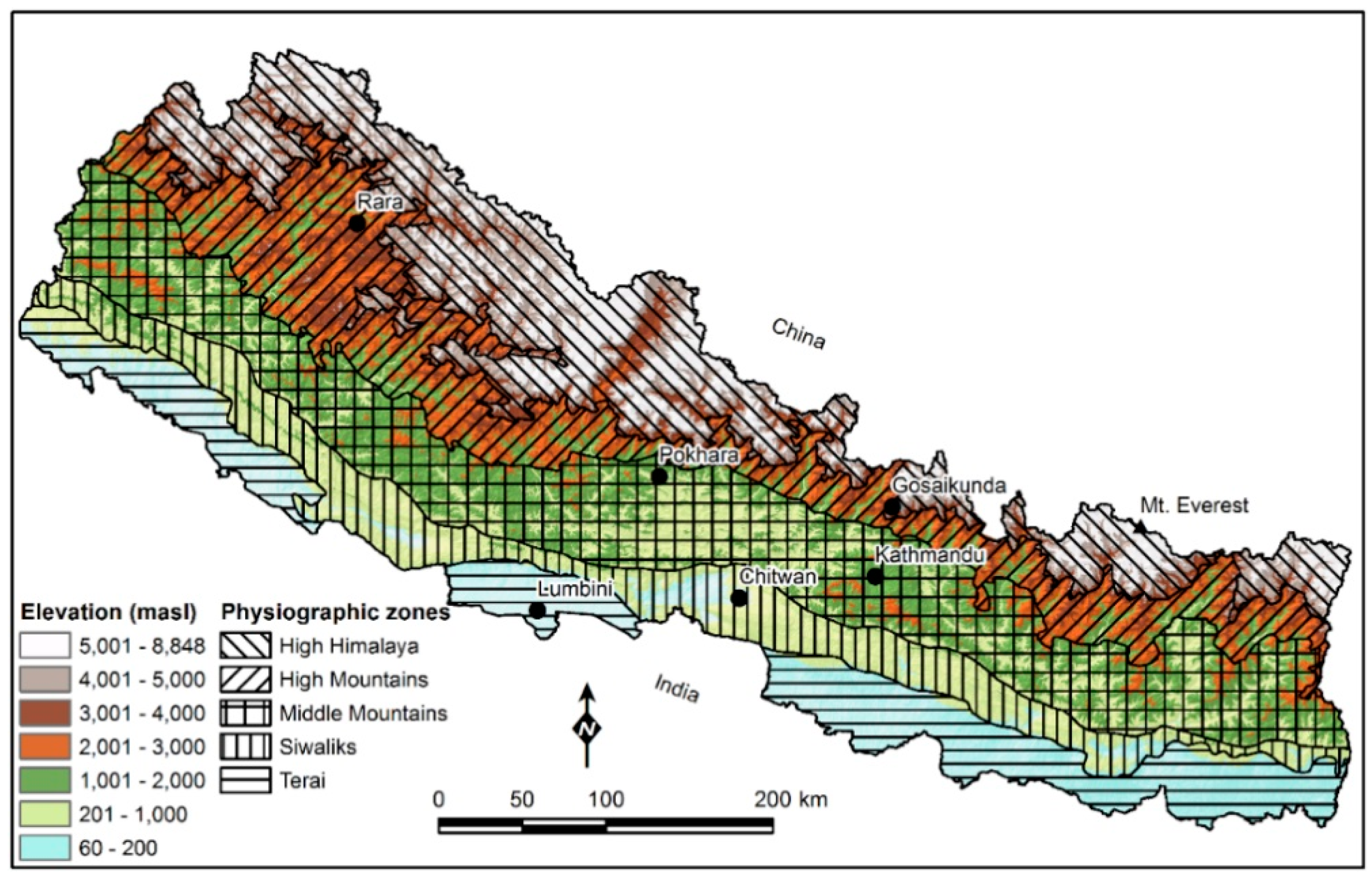
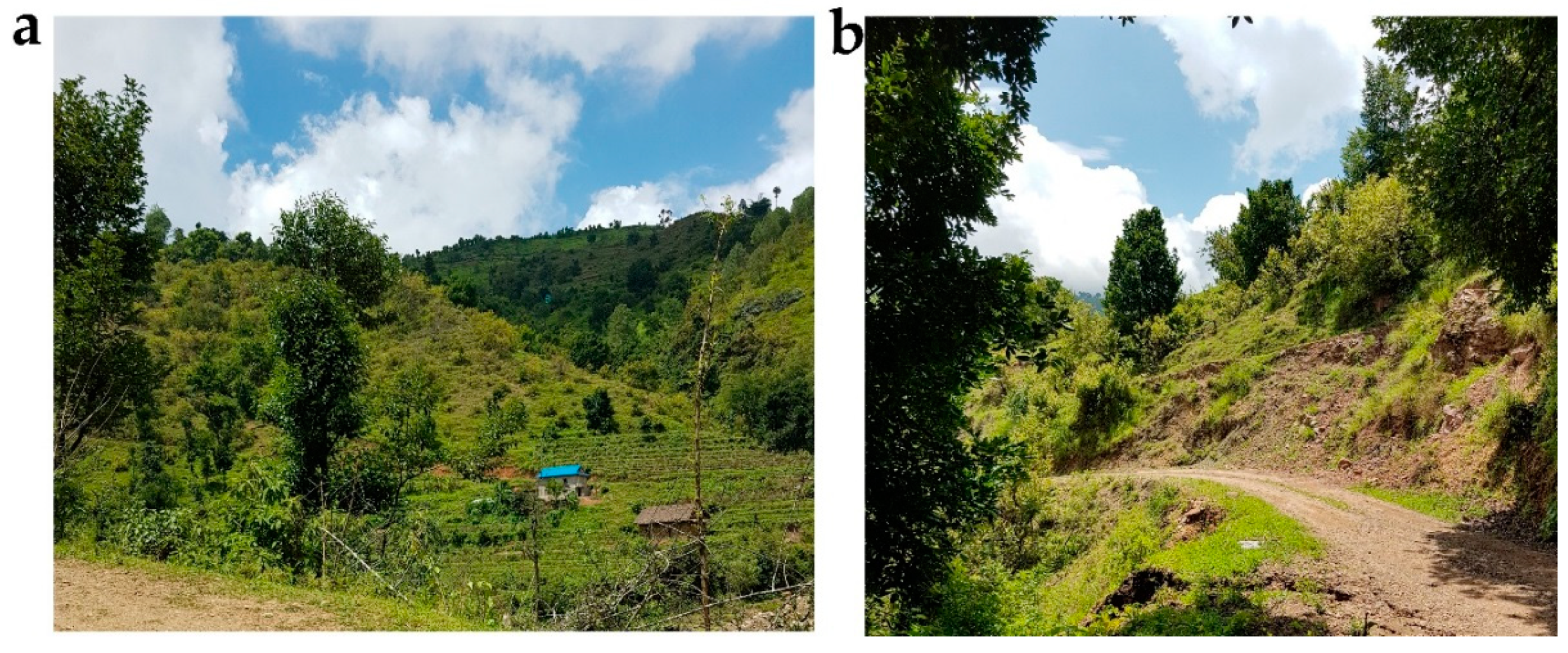

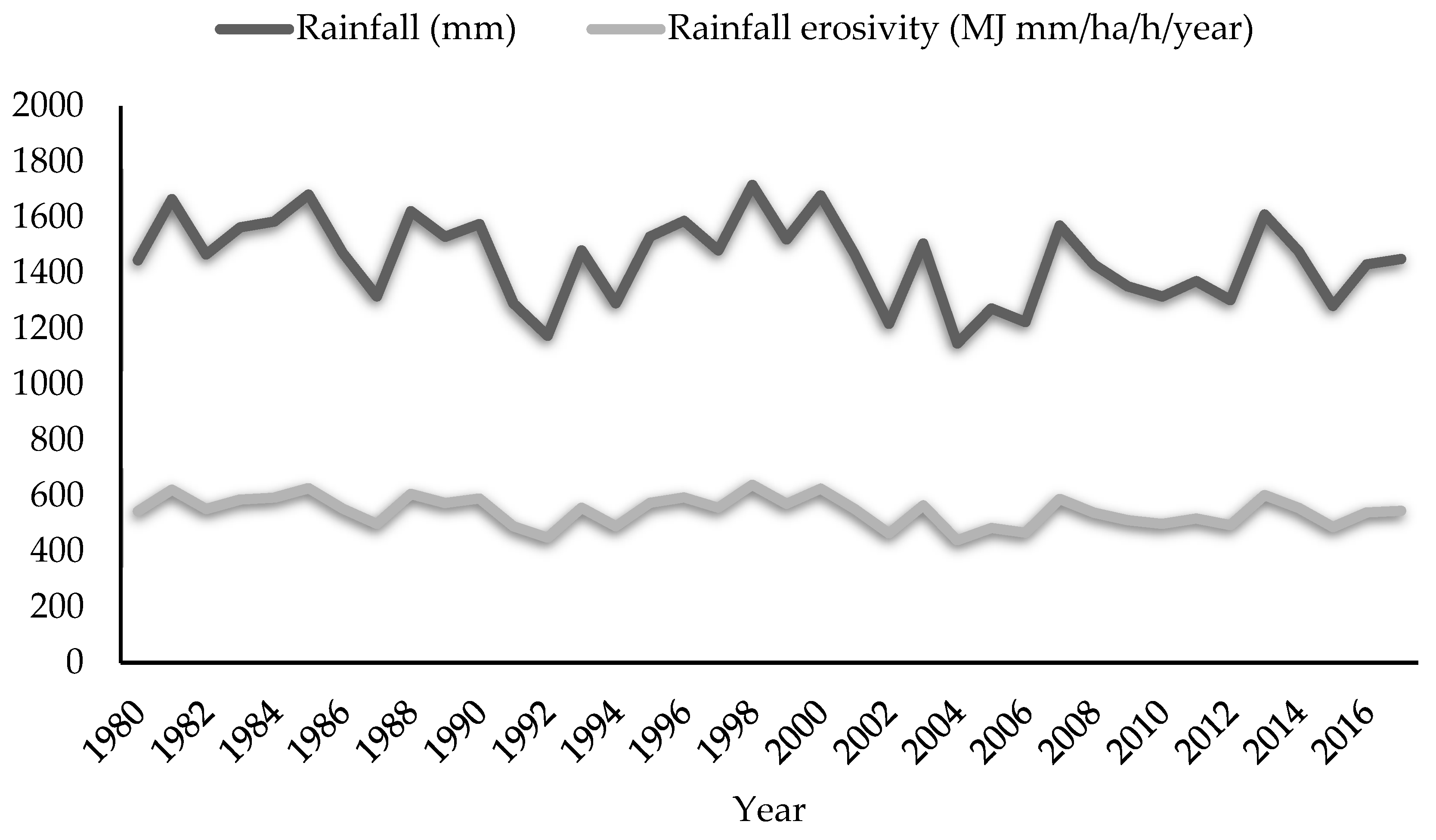
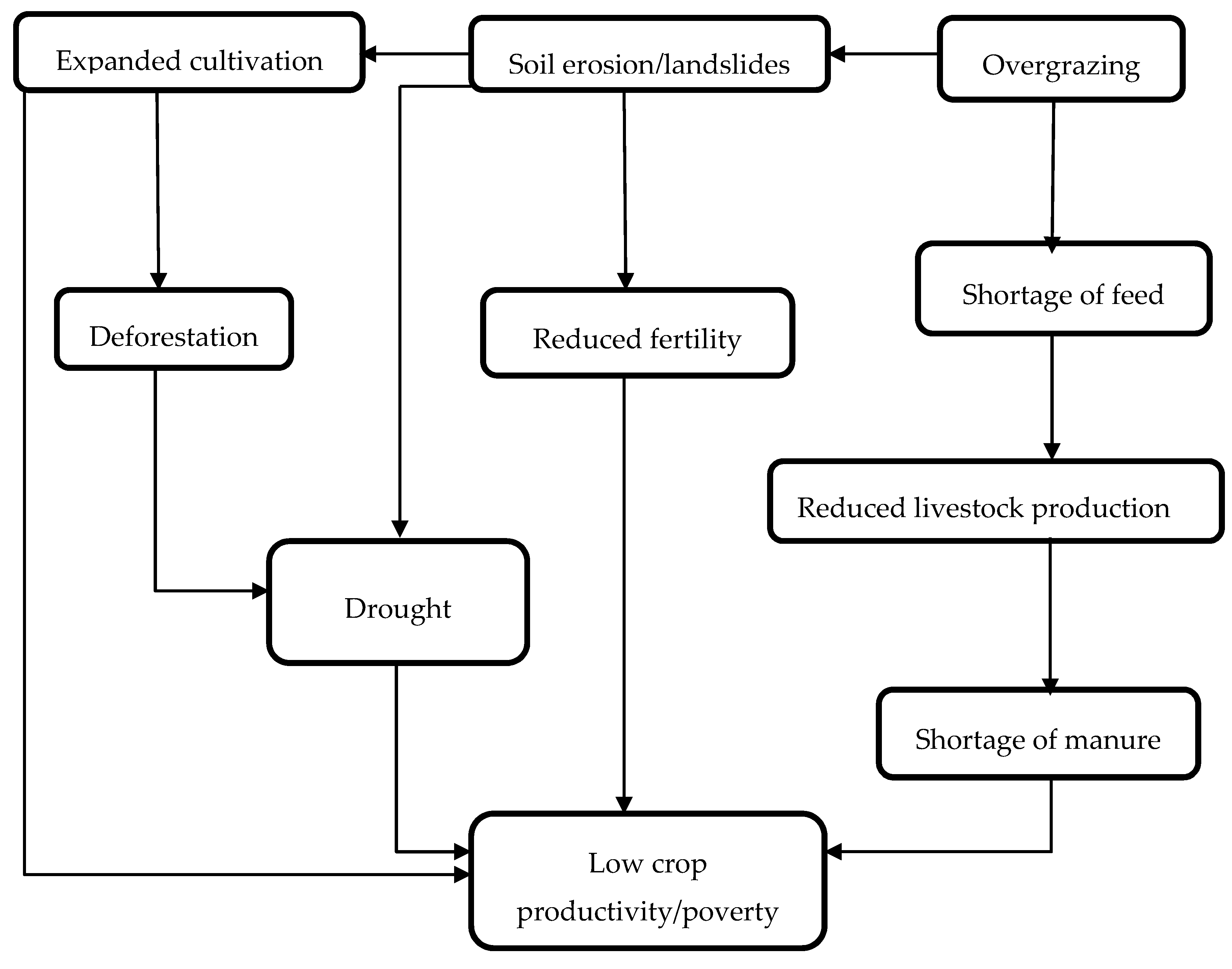
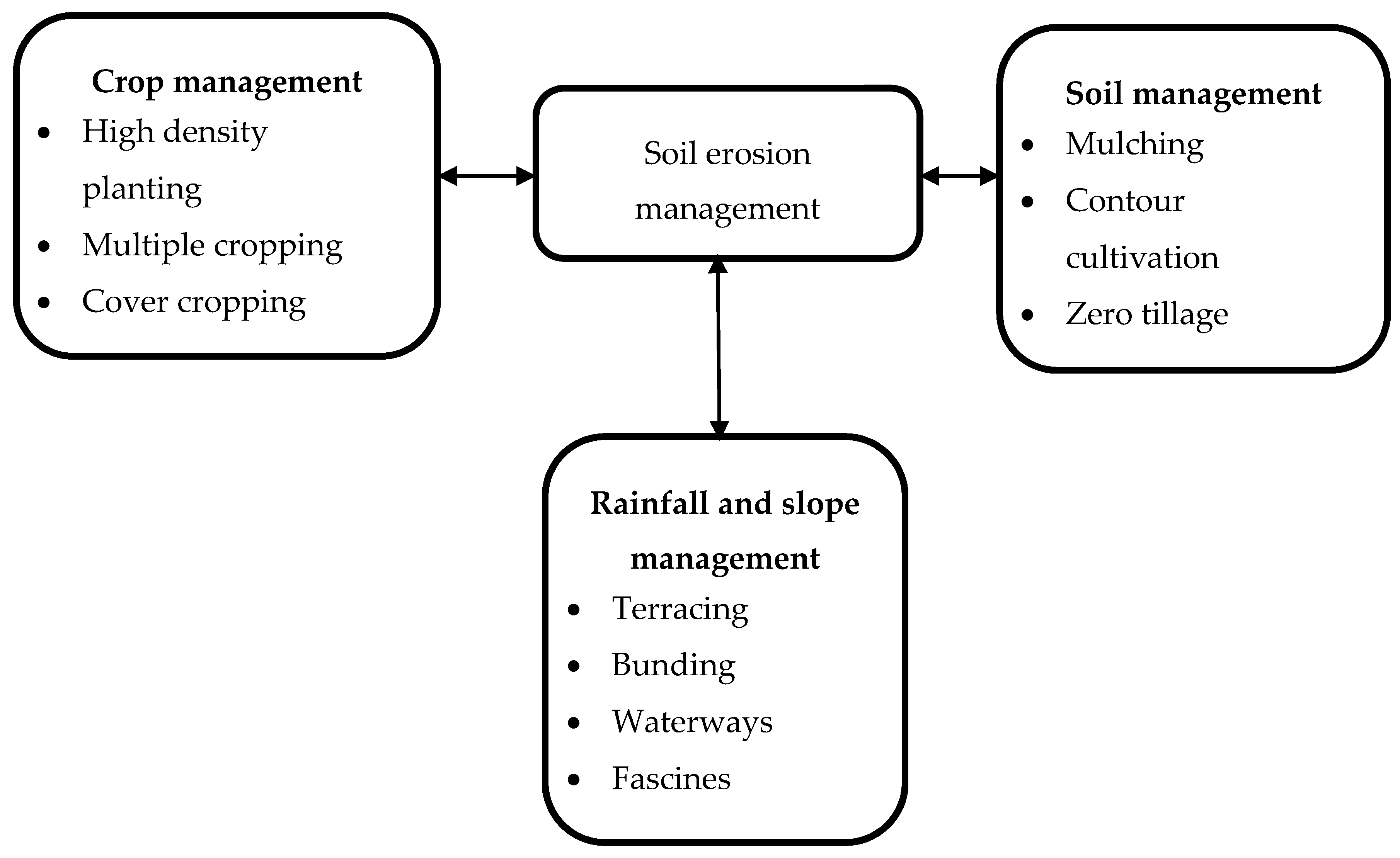
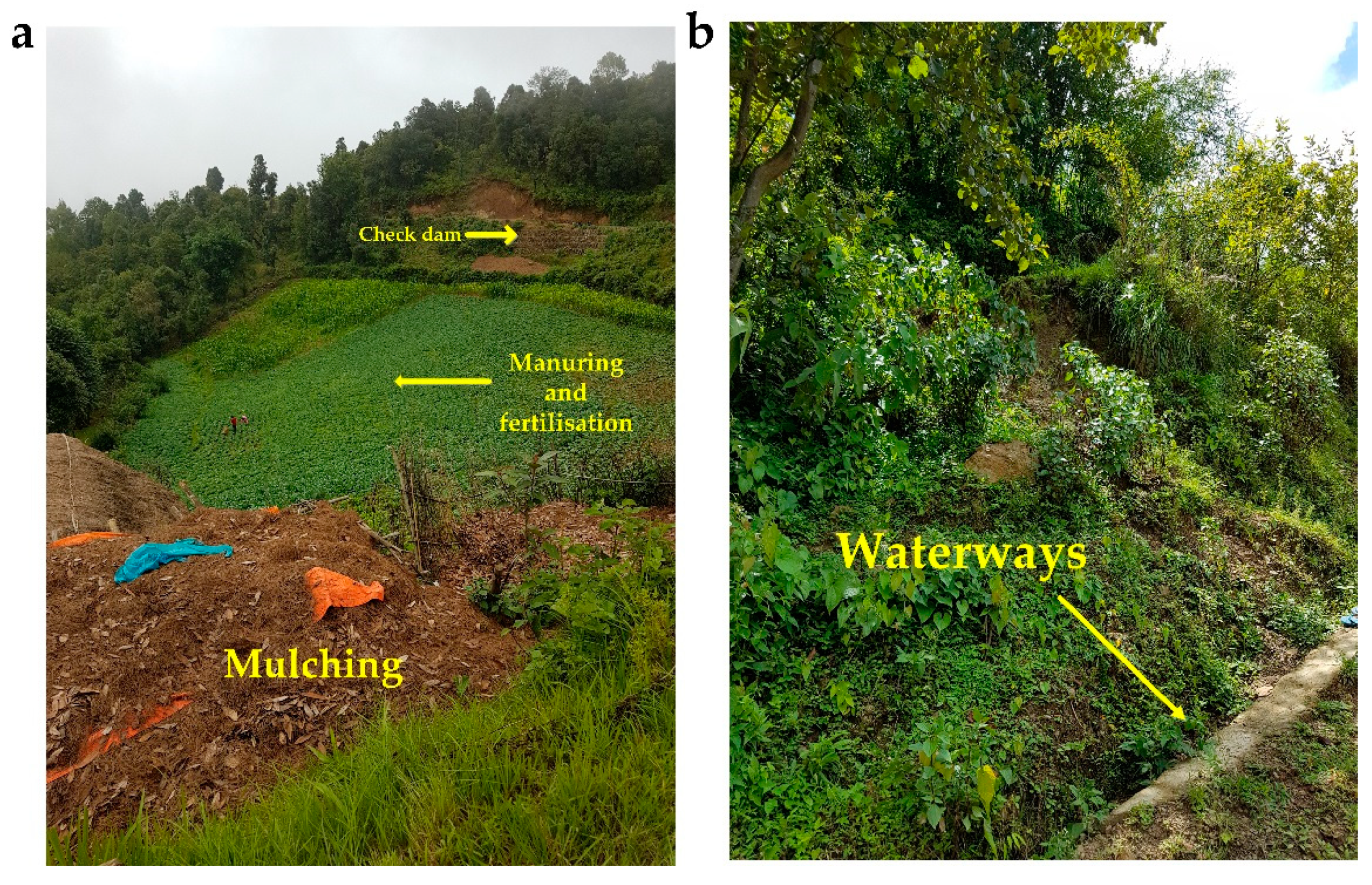
| Physiographic Regions | Elevation (m) | Common Land Degradation Types |
|---|---|---|
| High Himalayas | 4000–8848 | Rock slides, an outburst of glacial lakes |
| High Mountains | 2000–4000 | Mass wasting, bank cutting, rill, and inter-rill erosion |
| Middle Mountains | 1500–2700 | Mass wasting, rill erosion, inter-rill erosion, and bank cutting |
| Siwalik Hills | 700–1500 | Rill, inter-rill, and gully erosion |
| Terai Plains | 60–700 | Flooding, water logging, sheet erosion, and shifting of river courses leading to streambank erosion |
| Types of Land-Use | Total Degraded Land (million ha) | Total Land Area (million ha) | Degraded Land (%) |
|---|---|---|---|
| Forest | 2.22 | 5.83 | 38.07 |
| Pasture/rangeland | 0.65 | 1.75 | 36.97 |
| Agriculture (sloping terraces) | 0.29 | 2.97 | 9.77 |
| Land-Use | Average Soil Loss (t ha−1 year−1) | Range (t ha−1 year−1) |
|---|---|---|
| Upland | 28 ± 29 | 2–105 |
| Lowland | 0.7 ± 0.9 | 0–2.7 |
| Shrub | 58 ± 78 | 0.4–420 |
| Forest | 5.1 ± 4.7 | 0.2–15.3 |
| Restoration Measures | Study Area and Methods | Key Findings | Reference |
|---|---|---|---|
| Mulching | Maize planting with reduced tillage and rice straw mulching in Kathmandu University | Mulching reduced soil runoff by 18% | Atreya, et al. [43] |
| Strip planting | Strip planting with maize and legumes in the Palpa district | Strip crop technologies effective in reducing soil erosion through sieve-barrier effect | Acharya, et al. [61] |
| Cover cropping | Planting Napier grass on devastated gully catchment of the Pipaltar, Nuwakot district | Restored soil fertility and recovered the catchment (1995 to 2003) | Higaki, et al. [62] |
| Reduced tillage | Maize planting with conventional and reduced tillage practices in Kathmandu University | Compared to conventional tillage, reduced tillage decreased the loss of soil organic carbon, total nitrogen and exchangeable potassium by 62, 7 and 1.4 kg ha−1, respectively | Atreya, et al. [44] |
| Maize, cowpea, finger millet and capsicum planting with reduced and conventional tillage practices in the Pokhare Khola watershed | In comparison with conventional tillage, reduced tillage decreased soil erosion and sediment runoff by 23% and 9%, respectively. | Tiwari, et al. [63] | |
| Check dams | Planting Dalbergia sisso, Eucalyptus camaldulensis and bamboo along with small check dams in the degraded stream of the Sarlahi district | Stabilised the streams, reduced landslides, and soil erosion over a period of four years (2006 to 2010) | Dhital, et al. [64] |
| Use of vegetative and wire net check dams in the Bagmati river basin | Narrowed the flow of stream channels and reduced the river cuttings on the streambanks | Dhital and Tang [65] | |
| Hedgerows | Planting hedgerows in the contours in Godavari, Kathmandu | Reduction of soil loss by 80–99% | Ya and Nakarmi [66] |
| Hedgerows with intercropping systems to assess the effectiveness of SALT in Godavari, Kathmandu | Hedgerows significantly lowered runoff by 38–43% and soil loss by 72–89%, respectively | Lamichhane [67] |
| Plan | Expected Outcomes | Achievements | Shortcomings | Recommendations |
|---|---|---|---|---|
| 8th |
|
| Lack of infrastructures for commercialisation of agriculture | Modification and strengthening of planning process is required |
| 9th | Community soil conservation service extension to 75 districts | Extended to 55 districts only | No order situation hindered the implementation and budget diverted to the security sector | Necessary to bring hitherto left-out groups into the mainstream, focus on proper mobilisation, allocation, and utilisation of available resources |
| 10th |
|
| Lack of coordination in the management of community, leasehold, and government-owned forests | A district-level strategic plan should be developed and adequate public participation should be ensured. |
| 11th | Formation of new CFUGs: 2500 | CFUGs: 15,000 (total up to this plan) | Forest encroachment, soil erosion, forest fires | Formulation of policies focusing on decentralisation and local participation |
| 12th |
|
| Forest encroachment, soil erosion, forest fires, uncontrolled grazing | Formulation of policies focusing on decentralisation and local participation |
| 13th | Increase area under forests by at least 40% from 39.6% | Area under forests reached 44.5% | Devastating earthquake (April 2015), forest encroachment, forest fires | Formulation of policies focusing on decentralisation and local participation |
| 14th | Landslide control on 2000 places, water source conservation in 600 places | Running | ||
© 2019 by the authors. Licensee MDPI, Basel, Switzerland. This article is an open access article distributed under the terms and conditions of the Creative Commons Attribution (CC BY) license (http://creativecommons.org/licenses/by/4.0/).
Share and Cite
Chalise, D.; Kumar, L.; Kristiansen, P. Land Degradation by Soil Erosion in Nepal: A Review. Soil Syst. 2019, 3, 12. https://doi.org/10.3390/soilsystems3010012
Chalise D, Kumar L, Kristiansen P. Land Degradation by Soil Erosion in Nepal: A Review. Soil Systems. 2019; 3(1):12. https://doi.org/10.3390/soilsystems3010012
Chicago/Turabian StyleChalise, Devraj, Lalit Kumar, and Paul Kristiansen. 2019. "Land Degradation by Soil Erosion in Nepal: A Review" Soil Systems 3, no. 1: 12. https://doi.org/10.3390/soilsystems3010012
APA StyleChalise, D., Kumar, L., & Kristiansen, P. (2019). Land Degradation by Soil Erosion in Nepal: A Review. Soil Systems, 3(1), 12. https://doi.org/10.3390/soilsystems3010012






